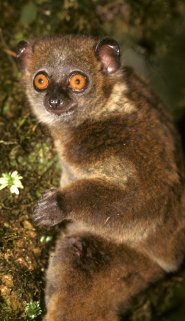 The small-toothed sportive lemur (Lepilemur microdon), also called the light-necked sportive lemur, is an extremely rare lemur only found on the southeastern forests of Madagascar. There are 26 species of sportive lemurs, all of which live on the island of Madagascar. They get their common name "sportive" because they are highly active little mammals, living in the treetops. There are no small-toothed sportive lemurs in captivity and an unknown amount still in the wild.
The small-toothed sportive lemur (Lepilemur microdon), also called the light-necked sportive lemur, is an extremely rare lemur only found on the southeastern forests of Madagascar. There are 26 species of sportive lemurs, all of which live on the island of Madagascar. They get their common name "sportive" because they are highly active little mammals, living in the treetops. There are no small-toothed sportive lemurs in captivity and an unknown amount still in the wild.This is an ancient species which is facing extinction due to habitat loss and from poaching. All lemurs need a large space filled with many type of trees in order to find enough to eat. Tree species flower and bear fruit at differing times or else the lemurs would starve. There is still a lot to be learned about the small-toothed sportive lemur but it may be gone forever if the forests of Madagascar are felled for farming.
Physical Description
A small-toothed sportive lemur looks like a cross between a monkey and a weasel. They have the long necks and long faces of a weasel, but the bodies and flexible hands of a monkey. Their short but dense fur varies in shades of brown from tan to chestnut on their backs and sides, but turns a pale grey to white on their necks, bellies and inside of the legs.
Adults weigh from 2 to 2.6 pounds (0.9 to 1.2 kilograms), which is lighter than a domestic cat. From head to tail-tip, adults measure 22 to 25 inches long (55 to 64 cm.) As their common name suggests, the small-toothed sportive lemur does have small teeth in comparison to other lemur species known at the time of its discovery in 1894. Their hands possess five long mobile fingers, excellent for scratching fur, grasping onto narrow tree limbs and grasping food such as leaves, flowers and fruit.
Behavior
Unlike many other primates, this is a lemur that prefers to live alone. Males use loud crow-like calls to mark the borders of their territories. Females also have territories. Males can overlap female territories when they come into season but males cannot trespass into another male’s territory, or they will fight.
Small-toothed sportive lemurs spend most of their lives leaping from tree to tree. They sleep during the day to avoid birds of prey and search for food at night. This species of lemurs also shares a trait with rabbits and guinea pigs – they excrete a special dropping called a cecotroph. This helps them to digest their tough, plant-based diet. If they do not eat their cecotrophs, they can die.
Picture of the Small-toothed Sportive Lemur by Edward E. Louis Jr., licensed under Creative Commons Attribution-Share Alike 3.0 Unported license.
The Light-necked sportive lemur, microdon sportive lemur, small-toothed sortive lemur is listed as Near Threatened (LR/nt), is close to qualifying for or is likely to qualify for a threatened category in the near future, on the IUCN Red List of Threatened Species
Namings for the smalltoothed sportive lemur
A smalltoothed sportive lemur group is called a 'troop'.Countries
Madagascar
Custom Search